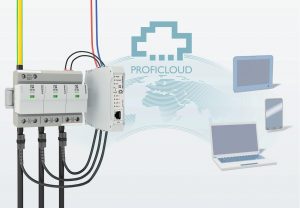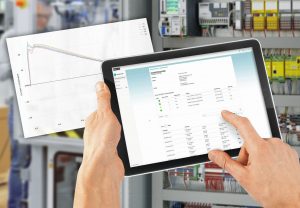Written by Dipl.-Phys. Claas Rittinghaus, Product Marketing Surge Protection, Business Unit Trabtech, Phoenix Contact GmbH & Co. KG, Blomberg, Germany
Condition Monitoring with ImpulseCheck
Surge protective devices are safety-related components and, as such, an essential part of process plants. Information about the status and performance of these components as well as on the status of the plant itself play an important role in continuous monitoring and predictive maintenance. ImpulseCheck acquires all this information – and also enables it to be utilized in the Internet of Things.
The green “OK” notification on a typical status indicator of an SPD (Surge Protective Device), displayed on the device itself or read out by means of a remote indication contact, is not indicative of the current status of the arrester. Neither does it provide any information on the specific stress caused by surge currents and transient overvoltages since the installation of the SPD. Taking a look at the indicator during the maintenance or periodic inspection of a lightning protection system thus isn’t very meaningful. The surge protective system might fail just the next day – or in a few years’ time.
This is where ImpulseCheck, Phoenix Contact’s new system, comes into play. Surge currents and transient overvoltages discharged and limited by the SPD are detected in real time, and can then be analyzed in ImpulseAnalytics – a Proficloud application. In addition to comprehensive tools for the evaluation of the measured data, which are available to the user, the state of health (SoH) for each mode of protection is calculated for Phoenix Contact SPDs. The state of health is the current state of the arrester. As opposed to former, purely reactive replacements of surge protective equipment based on the green/red status indicator, this status information allows for the implementation of predictive maintenance plans. The efficiency of maintenance work can thus be improved, money can be saved, and system availability better protected.
Connection to Proficloud
 The ImpulseCheck system consists of up to four external sensors, an evaluation and communication unit, and the ImpulseAnalytics Proficloud application. The sensors are connected to the cables connecting the SPD with the active conductors of the power supply. Surge currents and transient overvoltages discharged and limited by the SPD are detected by the sensors and processed by the evaluation and communication unit. Via Ethernet, the measured data are sent from there through an encrypted communication channel to the Proficloud. The ImpulseAnalytics application processes the measured data into typical characteristic quantities such as amplitude, electric charge, and specific energy, which can then be visualized, analyzed, and exported for specific evaluation purposes.
The ImpulseCheck system consists of up to four external sensors, an evaluation and communication unit, and the ImpulseAnalytics Proficloud application. The sensors are connected to the cables connecting the SPD with the active conductors of the power supply. Surge currents and transient overvoltages discharged and limited by the SPD are detected by the sensors and processed by the evaluation and communication unit. Via Ethernet, the measured data are sent from there through an encrypted communication channel to the Proficloud. The ImpulseAnalytics application processes the measured data into typical characteristic quantities such as amplitude, electric charge, and specific energy, which can then be visualized, analyzed, and exported for specific evaluation purposes.
The modular design of the system with external sensors and a separate evaluation and communication unit allows for a wide range of applications. Especially in large distributed plants with numerous subsystems, which often differ in terms of their exposure or resistance to surge voltages, critical locations can be monitored by means of ImpulseCheck to obtain a more differentiated picture of the current status of the plant. Depending on the application, the system can either be newly installed, retrofitted in existing plants with surge protection already installed, or used as a measuring device only, without any SPD to be monitored.
SoH calculation
One of ImpulseCheck’s core functions is to calculate the SoH for the individual modes of protection of the monitored Phoenix Contact surge protective device. The SoH indicates the remaining capability of the protective device, and recommends replacement where necessary – in fact, it does so reliably and before the device fails. The corresponding calculations are based on the data about surge currents and transient overvoltages, which were collected by ImpulseCheck since the installation of the SPD. The individual events are analyzed for their damaging potential regarding the SPD in question, and the accumulated stress resulting from numerous events during the service life is also taken into account.
 To do so, special algorithms are used that, for one thing, consider the various ageing mechanisms of the different surge protective components and, for another thing, use data from product development and standardized testing. Thanks to the cloud-based analysis, this intelligent evaluation can be continuously developed and fine-tuned. The approach also allows for future applications of Machine Learning technology.
To do so, special algorithms are used that, for one thing, consider the various ageing mechanisms of the different surge protective components and, for another thing, use data from product development and standardized testing. Thanks to the cloud-based analysis, this intelligent evaluation can be continuously developed and fine-tuned. The approach also allows for future applications of Machine Learning technology.
The ImpulseCheck Proficloud application enables the user to access the data measured by ImpulseCheck. For each conductor of the monitored power supply system, the detected surge currents are listed – including relevant characteristic quantities, such as amplitude, electric charge, and specific energy. The individual events can each be visualized by means of an integrated plotting feature, or be exported as a CSV data set. The data about the surge currents are determining for the calculation of the SoH – moreover, they provide information on the occurrence of overvoltages of atmospheric origin, or those caused by switching operations on inductive loads.
User-defined notifications
 For the detected transient overvoltages, a comprehensive analytical tool is available, allowing users to create individualized tables and histograms. This feature of ImpulseCheck can also be used to perform an EMC analysis of the plant regarding high-frequency interference. The time-specific mapping allows correlations between the operating states of individual system parts and the occurrence of electromagnetic interferences to be established (Fig. 4).
For the detected transient overvoltages, a comprehensive analytical tool is available, allowing users to create individualized tables and histograms. This feature of ImpulseCheck can also be used to perform an EMC analysis of the plant regarding high-frequency interference. The time-specific mapping allows correlations between the operating states of individual system parts and the occurrence of electromagnetic interferences to be established (Fig. 4).
Another important feature of ImpulseAnalytics is the possibility of configuring user-defined notifications. All kinds of events can be reported to any customized mailing list. Furthermore, a detailed status report on the current state of the monitored SPD can be created at the push of a button, or sent at regular intervals. The continuous calculation of the SoH in combination with the status report for documentation purposes eliminate the need for manual testing of surge protective devices as part of periodic inspections of lightning protection systems in accordance with IEC 62305-3.
To make the data of the ImpulseCheck system available also for control systems and other applications, ImpulseAnalytics features a REST interface that can be used to read out all status notifications and events. Thanks to this open architecture, the system is already primed for future developments and new digital business models.
Visit our website to learn more about the test device for surge protective devices.

